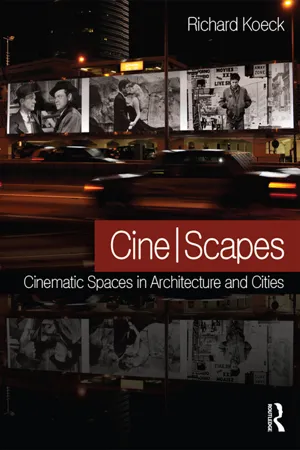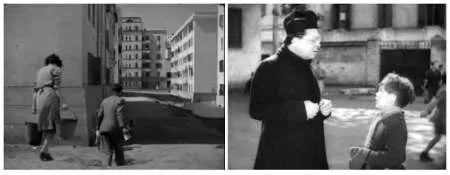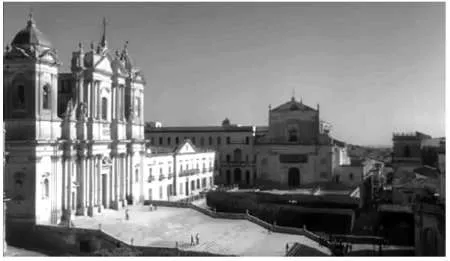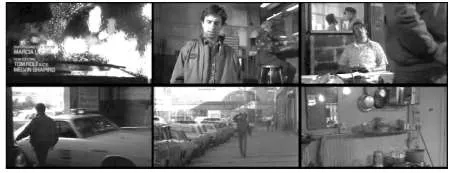![]()
Part I
Film, Mind and Body
![]()
Chapter 1
Tectonics of Film Space
Cinematographic drama is, so to speak, finer-grained than real-life encounters: it takes place in a world that is more exact than the real world. But in the last analysis perception permits us to understand the meaning of the cinema.
(Merleau-Ponty 1964: 58)
Writing Film Space
In Jean Baudrillard's perceptive travelogue, America, in which he conceptualises the emptiness and superficiality of the postmodern age, he concludes that in order to understand the ‘secret’ of this place, one should not start the investigation with the city and then consider the cinema, but instead one ‘should begin with the screen and move outwards to the city’ (Baudrillard 1988 [1986]: 56). I would like to follow this analogy with an investigation of what David B. Clarke calls ‘a conceptualization of the cityscape as screenscape’ (Clarke 1997: 1), and thus explore the role of space in film. In doing so, we will look more closely at key spatial moments from the history of cinema, which has arguably had a considerable influence on our perception and imagination of urban landscapes; an argument that will later become quintessential.
Weihsmann describes the portrayal of architecture in film as ‘the architecture of the filmic space’ (Die Architektur des filmischen Raumes), which in its original German text is a particularly appropriate description of the distinct tectonic quality of film space (Weihsmann 1995: 9). His words illustrate that film space is, in one sense, a mise-en-abyme (to borrow a term from literary and film theory), although this is not on the level of a two-dimensional frame, but rather on that of a three-dimensional space. Weihsmann notes that architecture seen in film is an intrinsic part of eingebunden, a complex play between form, meaning and symbol which frames psychological and aesthetic interpretations (ibid.: 56). Film is able to convey meaning with origins outside an immediate optical system, and can thus communicate more than just spatial coordinates assigned to a plot, a phenomenon that is linked by Weihsmann to our subconscious perception. This space within a space – cities and urban sites represented in film – reflects, as Aitken and Zonn note, ‘prevailing cultural norms, ethical mores, societal structures, and ideologies’ (Aitken and Zonn 1994: 5). However the question remains how, in cinema, such a conscious, or for that matter subconscious, ‘reflection’ is achieved and what role this phenomenon might play in our perception of actual city spaces. We will return to this in a moment, but not before briefly examining the different meanings of the term space in the context of film. What, then, are the characteristics that contribute to the tectonic quality of film space?
The effect of film is neither absolutely two-dimensional nor absolutely three-dimensional, but something between.
(Arnheim 1957: 12)
Rudolf Arnheim's study of the art of film alludes to the fascinating transgres-sive dimensional nature of film, and seems particularly relevant to a study of how film communicates spatial and architectural properties. For Heath, who shares Arnheim's fascination, it is the spatially-ambiguous character that the medium of film offers which is responsible for ‘the habitual response to the famous “impression of reality” in cinema’ (Heath 1976: 75). Weihsmann once said that ‘a film without any spatial bearing is simply unimaginable’ (Weihsmann 1995: 55). I would add that film is created by movement, and where there is movement there is also space. In other words, even the most abstract and experimental films — works of art using only shapes and movement, and omitting traditional pictures, as seen in the films of Viking Eggeling and Hans Richter in the 1920s — have a natural spatial dimension. When it comes to feature-length narrative films, where the pictures are shot on location or on purpose-built stage sets, the amount of spatial information embedded in moving pictures and spatial relationships, true or imagined, is inconceivably high, and in its totality is perhaps beyond the capacity of our sensory apparatus.
As a prelude to my journey through architectural moments in film, I would like to briefly diverge from the topic of filmic spatial perception and focus attention on urban filmmaking practice. Giuliano Bruno observes ‘The physicality of the street and of the social epidermis materialized into fiction as a formalized architectural aesthetic in postwar Italian neorealism’ (Bruno 2002: 30). She highlights that the Italian neorealist cinema of the mid-1940s to early 1950s made a key contribution to a mobilised screen-engagement with urban landscapes and the drama occurring within them. Bruno quotes André Bazin, who commented that Vittorio De Sica's classic masterpiece Ladri di Biciclette (1948, aka Bicycle Thieves) is ‘the story of a walk through Rome’ (see ibid. and Bazin 2005 [1971]: 55). Bazin's remark indicates a shift in Italian, and subsequently other, cinematic productions from being predominantly being shot in the studio to being shot on location. Roberto Rossellini's landmark production, Roma Città Aperta (Rome, Open City, 1945), was shot only a few months after the surrender of the Italian Campaign of World War II. However, Italian neorealist cinema was only the beginning of a
Figure 1.1 Screenshot. Bicycle Thieves. © Produzioni De Sica (left). Screenshot. Rome, Open City. © Excelsa Film (right).
new filmic vocabulary that was lost in the studio era of the 1920s to the 1940s. The French New Wave cinema was better connected to a critical discourse concerning modern urban conditions and, as such, it arguably placed an even greater focus on the centrality of shooting on location in cities and urban landscapes. Commenting on the opening shot of Alain Resnais' Hiroshima mon amour (1959), Richard J. Neupert notes that:
The camera travels slowly down the empty street; the opening clarinet music ends, and the viewer studies the street as if it were a starkly beautiful photograph, as deserted as an Atget photograph, come to life.
(Neupert 2007: 61)
This quote draws attention to the way in which the camera can capture the distinct spatial quality of urban settings, and to a film movement that made particular use of urban space, thereby marking a decisive moment in film history. Neuper's description of Resnais' film is a description of how filmmakers aimed to perfect a type of filmmaking in the late 1950s and 1960s which used the real city as a spatial and meaningful setting for their films. This is intellectually linked to theories and critical positions on film propagated by, for instance, Bazin and the magazine Cahiers du Cinéma, a group of filmmakers which included François Truffaut, Jean-Luc Godard, Éric Rohmer, Claude Chabrol, Jacques Rivette, Agnès Varda and Jacques Demy. These were part of a movement and spirit of the time that not only saw political revolts on inner-city streets, but also the development of the art of filmmaking. The French New Wave saw their film practice linked to what Alexandre Astruc called, in 1948, the new age of cinema as an age of camera-stylo (camera-pen), using new forms of cinematography, more mobile filming technology and real locations as mechanisms for the development of a new film language. Film, which has
Figure 1.2 Screenshot. L'Avventura. © Cino del Duca.
historically undergone a transformation from fairground attraction to a means of representation in boulevard theatres, was finally seen to be on its way to ‘becoming a means of expression, just as all the other arts have been before it, and in particular painting and the novel’ (Astruc 1968 [1948]; cited in Graham 1968: 17). Similarly, Monaco describes the French New Wave as a ‘tertium quid — a cinematic écriture that combines “language” and “style” and is “written” with a Caméra-Stylo’ (Monaco 2002: 19). Importantly, this newly-found consciousness of film as a medium promoted a series of stylistic expressions, which spread from France to other countries in the world. Films that are today recognised as milestones in film history, such as Michelangelo Antonioni's L'Avventura (1960), Federico Fellini's La Dolce Vita (1960) and Ingmar Bergman's Virgin Spring (1960), were notably European offshoots of the French New Wave (ibid.: 20), although the movement's influence was also felt across the Atlantic.1
It is this notion of the cinematic écriture that I believe to be important in the filmic act of rendering the essence of architectural qualities in movies. Some readers may have experienced, as have I, cine-spatial moments – in other words, moments in which portrayed architectural settings have left an imprint in their cinematic memory. In my case, some of these cinematic impressions were so powerful that they began to shape the boundaries of lived reality (see also Pallasmaa 2001: 23), and I have reason to believe that this experience is not mine alone. When teaching film and architecture, I tend to ask students who have not been to the United States to give me a spatial description of New York. I have yet to meet someone who could not
Figure 1.3 Screenshots of Taxi Driver. © Columbia Pictures Corporation.
give an impression of the sort of spaces one would find in that city, the sort of urban activity that would take place there, and how it would feel to live in it. These imagined impressions come to a great extent from the fact that they have seen countless films set in New York which have contributed to the construction of a cinematic montage of spatial impressions in their minds. How is this achieved? To answer this question, it is worth a closer reading of a particularly iconic city film, Martin Scorsese's Taxi Driver (1976), with Robert De Niro, Jodie Foster, Albert Brooks and Harvey Keitel in the leading roles. I will not so much concentrate on the plot of the film (an approach that resides in the field of film studies), but rather I will focus on some of the film's cine-spatial articulations, namely their textural, haptic, acoustic and other properties that, communicated through audio-visual media, contribute to a sense of space.
Traditionally, the opening shots of a film set the scene and are, therefore, particularly rich in spatial information. Taxi Driver is no exception to this rule. The opening credits show steam rising from the city's underground canal system, which is accompanied by Bernard Herrmann's moody saxophone musical score, produced shortly before his death. After briefly being introduced to our main protagonist, Travis Bickle (Robert De Niro), through an extreme close up (ECU), the blurred lights of the city materialise through the rainy windscreen of his taxi, using point of view (POV) shots as if filmed from inside the vehicle. Slow motion shots give us brief glimpses of people crossing a busy street in night-time New York, before the camera leaves the steam and mist behind and follows Travis as he enters the office of the taxi agency. The following internal shots, which frame a conversation between Travis and his prospective employer, are remarkably rich in architectural texture. The ringing of a traditional American telephone bounces off the walls of unrendered concrete block-work, and broken light switches, florescent light fixtures, squeaking doors and poorly-painted walls further create a spatially-tight architectural setting for Travis's famous line: ‘I'll work anytime, anywhere’. As Travis makes his way out of the office again, he traverses a half-indoor, half-outdoor space that vocalises ‘New York City’ across every inch of the screen. The camera pans over a poorly-lit garage that is filled with a fleet of incoming and outgoing iconic yellow New York City cabs. Travis's third space, finally filmed as a wide shot (WS), gives a brief respite from the previously claustrophobic places. It permits an acoustic and visual glimpse of New York's roads and sidewalks, before changing the spatial setting once again from the anonymity of the street to the intimacy of his apartment. Pallasmaa remarks elsewhere that ‘Architectural imagery and the articulation of space create the basic dramatic and choreographic rhythm of any film’ (Pallasmaa 2001: 32). This is certainly the case in Taxi Driver, where a carefully choreographed sequence of what To m Gunning (1991) describes as ‘pro-filmic’ spaces begin to form an emotional map of Travis's mind and the spaces he occupies both cognitively and physically.
The deconstructed analysis of Taxi Driver outlined above exemplifies the richness of a cine-spatial moment which, in real-time, only lasts a few minutes. It is intended to illustrate the spatial depth of the film that we do not all see. Film provides us with an infinite amount of spatial information, which we can never process in its entirety when watching a film for the first time. Watching a movie requires us to select information, and the magic of film lies in the fact that our brain fills in the blanks, just as it does when in real life urban scenarios. Furthermore, it creates spatial impressions without the need of a nuanced analysis of all the spatial information that unfolds in front of us. Pallasmaa notes that ‘A street in a film does not end at the edge of the screen; it expands all around the viewer as a network of streets, buildings and life situations’ (Pallasmaa 2001: 21), and the same is also true when watching a film about New York. Although we might never have physically been to New York ourselves, we seem to know the city, and can make connections between the spaces we see and the filmic narrative. This enables us to draw conclusions, not just with regard to spatial relationships in the city, but also to the structure of social relationships linked to a place.
Instruments of Spatial Communication
Ever since the earliest days of filmmaking, pioneers such as George Méliès (who used painted stage sets to create an illusion of place) were concerned with the manipulation of a screen space. He recognised, as have many others...



